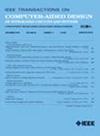A Highly Reliable Dual-Mode RRAM PUF With Key Concealment Scheme
IF 2.9
3区 计算机科学
Q2 COMPUTER SCIENCE, HARDWARE & ARCHITECTURE
IEEE Transactions on Computer-Aided Design of Integrated Circuits and Systems
Pub Date : 2025-01-28
DOI:10.1109/TCAD.2025.3536376
引用次数: 0
Abstract
Physical unclonable function (PUF) has been widely used in the Internet of Things (IoT) as a promising hardware security primitive. In recent years, PUFs based on resistive random access memory (RRAM) have demonstrated excellent reliability and integration density. Most previous designs store PUF keys directly in RRAMs, increasing vulnerability to attacks. This article proposes a dual-mode RRAM PUF, named differential mode and flexible mode, utilizing the difference in switching capability between RRAMs during parallel SET operations as the entropy source. The proposed PUF can reliably reproduce keys between cycles, so a key concealment scheme is used to protect PUF keys from being continuously exposed, improving the security of the RRAM PUF. The proposed RRAM PUF exhibits high reliability over ±10% VDD and a wide temperature range from −25°C to 125°C through post-processing operations. The flexible mode can generate a significant number of keys for high-security applications. Since the PUF keys can be concealed, the proposed PUF is compatible with in-memory computing. It can be implemented using the same RRAM array as experimentally validated using a MAGIC operation, thus reducing the hardware overhead.具有密钥隐藏方案的高可靠双模RRAM PUF
物理不可克隆函数(PUF)作为一种很有前途的硬件安全原语,在物联网中得到了广泛的应用。近年来,基于电阻式随机存取存储器(RRAM)的puf显示出优异的可靠性和集成密度。大多数以前的设计将PUF密钥直接存储在ram中,增加了攻击的脆弱性。本文提出了一种双模RRAM PUF,称为差分模式和灵活模式,利用并行SET操作时RRAM之间切换能力的差异作为熵源。该PUF可以在周期之间可靠地复制密钥,因此采用密钥隐藏方案来保护PUF密钥不被连续暴露,提高了RRAM PUF的安全性。所提出的RRAM PUF在±10% VDD下具有高可靠性,并且通过后处理操作具有- 25°C至125°C的宽温度范围。灵活的模式可以为高安全性的应用生成大量的密钥。由于PUF密钥可以隐藏,因此所提出的PUF与内存计算兼容。它可以使用与使用MAGIC操作实验验证的相同的RRAM阵列来实现,从而减少硬件开销。
本文章由计算机程序翻译,如有差异,请以英文原文为准。
求助全文
约1分钟内获得全文
求助全文
来源期刊
CiteScore
5.60
自引率
13.80%
发文量
500
审稿时长
7 months
期刊介绍:
The purpose of this Transactions is to publish papers of interest to individuals in the area of computer-aided design of integrated circuits and systems composed of analog, digital, mixed-signal, optical, or microwave components. The aids include methods, models, algorithms, and man-machine interfaces for system-level, physical and logical design including: planning, synthesis, partitioning, modeling, simulation, layout, verification, testing, hardware-software co-design and documentation of integrated circuit and system designs of all complexities. Design tools and techniques for evaluating and designing integrated circuits and systems for metrics such as performance, power, reliability, testability, and security are a focus.

 求助内容:
求助内容: 应助结果提醒方式:
应助结果提醒方式:


